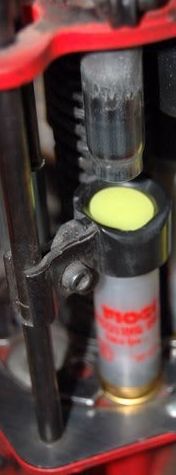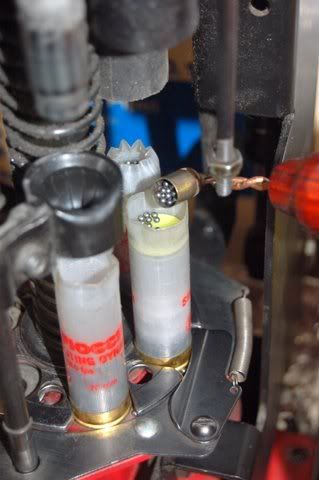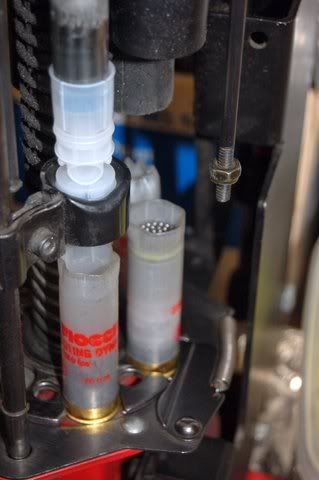Spreader Loading Redux....
I load my spreaders on my MEC 9000G in progressive mode.
I seat the wad and drop 7/8 ounce of shot. I raise the handle 1/2 way, enough for the drop tube to clear, but not enough to release the shell carrier and index the shell.

Holding the handle 1/2 way up, I place the PW disc in the wad guide...

Then I seat the disc with very light pressure, again not enough to actuate the bar.

On the full upstroke the shell with disc moves to the crimp start station and a new hull arrives with powder....

Using a 1/8 ounce shot dipper made from a cut down .38 case soldered to a wire handle, I add 1/8 ounce on top of the disc and continue....

As I seat the wad and drop 7/8 ounce in the new shell with a full downstroke, the previous shell will be crimp-started...

I raise the handle halfway and pause, put a disc in place and continue.

As I said, once I hit my rhythm, I can load a box in 4 minutes; That's a flat in less than one hour. When I was shooting 20 tournaments/year, a flat lasted about 2 years.
To the group at large:
When you modify the discs, what size holes will you use? What size shot will pass through? How many shot will pass thru? Will there be bridging? These shot that pass thru, where will they end up in the pattern? Will you space the holes evenly, so that balance is maintained? How many patterns will you have to analyze before you will know?
You can sort these things out for yourself, or just buy some that are precisely mass-produced. Discs with 3 holes in them have been available from Polywad for more than 20 years.
Seems the time spent punching holes in front of the TV would be better spent in the kitchen sorting the fly poop from the pepper.
When you try the layering technique, consider this:
With 100% of the shot beneath the Spred-R disc I get the widest spread patterns of a dozen different approaches. But there is a statistically significant occurrence of large voids in those patterns, even apart from the typically weak centers.
The shot I put on top of the disc, let's say 50 pellets, are oblivious to the disc. That means they see the full effect of the choke. If it's a tight choke to begin with, it isn't hard to imagine that the majority of those 50 pellets will be distributed about the center of the pattern. And it isn't hard for me to imagine that a sufficiently geeky person could adjust the layers to tune pattern width and density for a specific application.
BTW, I didn't invent the layering technique. I merely tested it and shared it extensively over the last 5 years.